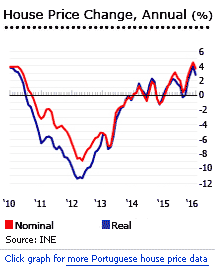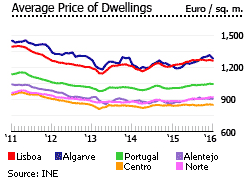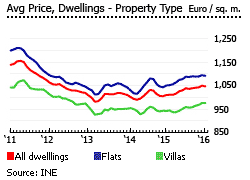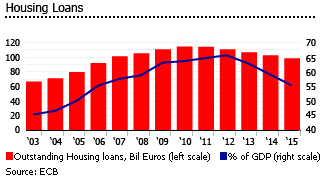Portuguese house prices continue to rise as its economy recovers
 Portugal’s housing prices are rising rather strongly, amidst a recovering economy. Property prices in Portugal rose by 3.66% (2.78% in real terms) in January 2016 from a year earlier, to an average price of €1,047 (US$1,168) per square metre (sq. m.), based on figures released by Statistics Portugal (INE). After more than three years of depression, house prices in Portugal started to recover in 2014.
Portugal’s housing prices are rising rather strongly, amidst a recovering economy. Property prices in Portugal rose by 3.66% (2.78% in real terms) in January 2016 from a year earlier, to an average price of €1,047 (US$1,168) per square metre (sq. m.), based on figures released by Statistics Portugal (INE). After more than three years of depression, house prices in Portugal started to recover in 2014.
In Lisbon metropolitan area, property prices were up by 3.69% (2.81% in real terms) y-o-y in January 2016, to an average of €1,266 (US$1,412) per sq. m.
Among urban areas, Barcelos saw the highest annual increase in house prices of 10.9% y-o-y in January 2016, followed by Amadora (9.4%), Vila Franca de Xira (7.4%), Porto (7.2%), Odivelas (7%), Maia (7%), Cascais (6.9%), Loures (6.4%), Funchal (6%), Oeiras (5.2%), and Lisboa (5.2%).
Modest to minimal house price increases were also registered in Coimbra (4.5%), Leiria (4.2%), Vila Nova de Famalicão (4.1%), Almada (3.9%), Braga (3.7%), Setúbal (3.7%), Sintra (3.1%), Seixal (2.9%), Guimarães (2.2%), Vila Nova de Gaia (2.2%), and Matosinhos (0.3%).
House prices were unchanged in Santa Maria da Feira while it dropped by 0.9% in Gondomar during the year to January 2016.
By property type:
- Flats prices rose by 3.9% (3% in real terms) y-o-y in January 2016
- Villa prices rose by 3.6% (2.7% in real terms) y-o-y in January 2016
“Portugal´s property market is booming once more!" said Chris White of the real estate firm Ideal Homes Portugal. "Sales have increased hugely this year and we´ve seen a significant shift in buyer profile as increasing numbers of investors realize the potential of the Portuguese real estate sector."
There are no restrictions on foreign property ownership in Portugal and transaction costs are generally low.
Portugal will grant a 5-year residency permit to non-EU citizens who buy a minimum of €500,000 worth of property. The permit allows holders to work or study, as well as to travel in Schengen countries. They can opt to apply for permanent residency after five years.
Property prices in Portugal remain below their peak levels
All regions of Portugal have experienced significant house price falls since late 2007. And despite some recovery in 2009, house prices started to fall again in the last quarter of 2010. Prices only began to recover in Q4 2014, after 13 consecutive quarters of y-o-y house price declines.
HOUSE PRICE CHANGE (%), January 2016 |
||||
| Average price (€/sq. m.) |
Y-o-Y change (%) |
M-o-M change (%) |
Change from peak (%) | |
| PORTUGAL | 1,047 | 3.7 | -0.3 | -11.1 |
| AM Lisboa | 1,266 | 3.7 | -0.5 | -12.6 |
| Norte | 925 | 3.9 | 0.2 | -7.5 |
| Centro | 853 | 0.9 | -0.5 | -13.6 |
| Alentejo | 911 | 5.0 | 0.1 | -14.5 |
| Algarve | 1,287 | 6.0 | -2.4 | -13.7 |
| Azores Islands | 977 | 4.9 | 0.8 | -14.1 |
| Madeira | 1,230 | 5.4 | -0.5 | -15.0 |
| Source: Instituto Nacional de Estatistica (INE) | ||||
In January 2016, Alentejo was still 14.5% down on its peak, while Centro was down 13.6%. House prices in the Algarve were 13.7% down, and in AM Lisboa 12.6% down. Norte had the lowest price drop from the peak, at just 7.5%.

In the autonomous regions of Madeira and Azores Islands, house prices remain 15% and 14.1% down from the peak, respectively.
The house price boom that swept most of Europe and the developed world from the mid-1990s to 2006 completely by-passed Portugal, except in the Algarve:
- 2003 - 2004: house prices rose by an average of 6.2% y-o-y (3.3% in real terms);
- 2005 - 2007: prices rose by an average of 1.25% (-1.3% in real terms);
- 2008: prices fell by an average of 4.7% (-7.1% in real terms);
- 2009: prices fell by an average of 2.6% (-1.8% in real terms);
- 2010 - 2012: house prices fell by an average of 3.1% (-5.5% in real terms);
- 2013-2014: house prices dropped by an average of 1.5% (-1.5% in real terms), and;
- 2015: house prices rose by 4.5% y-o-y (4% in real terms).
Why did Portugal miss the boom? Largely because of sluggish economic growth, with a contraction of 0.9% in 2003 and an average growth of just 1.2% from 2004 to 2008. In 2009, the economy contracted by 3%. Although it grew by 1.9% in 2010, Portugal’s GDP fell again by an average of 2.5% annually from 2011 to 2013. The economy expanded by 1.5% in 2015, after meagre growth of 0.9% in 2014.
Portuguese property is very inexpensive.

If we were to take account of inflation, the price declines mentioned above would be even larger. Currency falls are another factor. During the past two years (2013-2015), the Euro has fallen by around 21% against the US Dollar, and around 12% against the Sterling, so from the perspective of the foreign buyer, Portuguese property prices are exceptionally low.
In fact Portuguese property is astonishingly good value. The most expensive housing in Portugal can be found in Algarve, with an average price of €1,287 (US$1,436) per sq. m., and in AM Lisboa with €1,266 (US$1,412) per sq. m. in January 2016. Global Property Guide’s Lisbon square metre house price research finds that Lisbon city-centre prices are higher, at around €2,464 (US$2,749) per square metre for 175 sq. m. Lisbon apartments. On the other hand, a 120 sq. m. apartment in Algarve is priced around €1,617 (US$1,804) per square metre.
Portugal’s house price to GDP per capita ratio is one of the lowest in Europe, according to Global Property Guide research (see table). Again in terms of square metre prices, Portugal has some of the lowest prices for city-centre property in Europe, according to Global Property Guide research (see table).
Lisbon’s rental yields are moderate to good
Lisboa apartments obtain moderate to good rental yields, ranging from 4.94% to 6.41%, according to the Global Property Guide rental yields research of November 2015. As a reminder, the rental yield is the total percentage return you would earn as a landlord, when renting out your property. Smaller apartments tend to be most profitable. A 60 sq. m. apartment in Lisboa returns around 6.41% rental yields, whereas a 200 sq. m. apartment returns only 4.94% rental yields. Moderate rental yields are also observed from villas in Lisboa, and again the rule is the larger the villa, the lower the yield.
Gross rental yields from apartments in Algarve are moderate, ranging from 3.52% to 3.79%, On the other hand, Algarve villas have poor rental yields, at around 2.5% only.
In Lisboa, rents from apartments range from about €8 to €10 per sq. m. per month, so that a 120 sq. m. apartment can be rented for about €1,000 (US$1,116) per month. Villas in Lisboa rent out for around €7.50 to €10 per sq. m. per month, and a 300 sq. m villa can be rented for around €2,100 (US$2,343) per month.
Rents from apartments in the Algarve lower, ranging from around €4 to €5.5 per sq. m. per month, so you can expect monthly rental income of about €560 (US$625) from a 120 sq. m. apartment. Villas in the Algarve rent for around €5 per sq. m. per month, so you can expect monthly rental income of about €1,635 (US$1,824) from a 350 sq. m. villa.
In terms of price to rent ratios, a significant indicator of value, Global Property Guide research suggests that Lisbon is exceptionally good value, now that reform of the rental system has been achieved.
Interest rates are astonishingly low

Interest rates on housing loans have continuously declined after reaching since 2012:
- Interest rates on housing loans fell to a record low of 1.2% in January 2016, from 1.34% in January 2015, 1.43% in January 2014, 1.54% in January 2013, and 2.72% in January 2012, according to the INE. This was partly due to the recent rate cuts of the European Central Bank (ECB), from 1.5% in October 2011 to 0.05% in September 2014.
- The mortgage market is extremely sensitive to interest rate changes, since about 93.2% of new mortgage loans have variable interest rates or initial rate fixation of less than one year, according to the European Mortgage Federation (EMF).
Shrinking mortgage market
Portugal’s mortgage market size has grown from 41.5% of GDP in 2000 to 65.6% of GDP in 2012. But housing loans have declined for the past five consecutive years (-0.5% in 2011, -3% in 2012, -3.6% in 2013, and -3.9% in both 2014 and 2015). As a result, the mortgage market shrunk to 62.9% of GDP in 2013, 59.2% of GDP in 2014, and finally to 55.5% of GDP in 2015. In 2015, the total amount of outstanding housing loans stood at €98.52 billion (US$109.91 billion), according to the European Central Bank (ECB).

Decline the very low interest rates, housing loans declined further by 3.8% in January 2016 from the same period last year, to €98.3 billion (US$109.67 billion). Investors remain reluctant to invest in the eurozone as its future remains uncertain.
Pent-up rental demand - new tenancy law
Portugal has one of the highest owner-occupation rates in Europe, generous government mortgage subsidies having helped push up owner occupation from 52% of all housing in 1981, to 74% in 2013. Meanwhile the private rental market has shrunk from 39% of total dwelling stock in 1981, to 18% in 2008. The social rental sector is small at around 3% of the total housing stock, or 16% of total rental stock.
The shrinking of the private rental market was caused by tenancy laws that discouraged landlordism by giving tenants controlled rents and protecting them against eviction. As a result, young people either live at home, or pay exorbitant key money, or buy an apartment.
his has led to a considerable pent-up demand for rental housing.
Rents have rarely been sufficient to maintain dwellings in good condition. Most landlords previously refused to rent due to “lack of collateral” according to Antonio Frias Marques, president of the National Association of Landlords (NPA). Despite this there is actually substantial oversupply, with a relatively high degree of second-home ownership (19.3% in 2011) and vacancy (12.5% of housing stock in 2011).
New lease law 31/2012
On August 14, 2012, the Portuguese government approved new legal measure, Law 31/2012, to reform the current urban lease regime. It is part of the condition for the country’s €78bn bailout agreement from the IMF, ECB and European Commission.
Changes in the law include the following:
- The new legislation allows parties to agree on any specific period for the duration of the lease, instead of the previous minimum of 5 years. If a period is not defined in the contract, the lease is assumed to be set for two years, which can be renewed automatically.
- There is now a procedure for revising rental values: (1) landlord proposes a new rent to the tenant; (2) the tenant accepts or suggests a counterproposal; (3 if no agreement is reached the agreement may be terminated, and the landlord pays five years’ worth of rent as compensation. Exemption is given to tenants with financial difficulties, who enter a transitional regime with small rent increases for five years. A special transitional regime is also applicable to tenants over 65 years old, or with 60% disability.
- As with the previous law, in case of death of the tenant, the lease will be transferred to the spouse, common law spouse, or relatives, but now only for a period of two years. The tenant’s beneficiaries are not allowed to hold purchased or rented property within the same municipality, or in Lisbon and Oporto’s case in neighbouring municipalities either.
The new law also strengthens the landlord’s ability to terminate a lease agreement:
- The landlord has the right to terminate the contract if the tenant fails to pay two consecutive rents and still hasn’t paid the rents due at the end of the third month.
- If the tenant fails to pay on time (or more than eight days after the due date) for four times in a year, the landlord can terminate the contract.
- The landlord is allowed to terminate the contract by notifying the tenant of its intention to terminate the contract with at least two years notice.
- If the landlord wishes to demolish or undertake works on the property, he may also terminate the lease.
The law aims to update the rents of older contracts, as well as amending the Law 6/2006 or the New Urban Lease Act (Novo Regime de Arrendamento Urbano – “NRAU”) – an attempt to solve old lease issues.
The new legislation also includes a special procedure on evicting tenants who do not vacate the property on the specified date by the court or the contract. It also creates the National Office for the Leases (Balcão Nacional de Arrendamento) where a landlord may apply so as to notify the tenant to vacate the property.
Landlords felt the new laws were long overdue. According to the President of the Lisbon Property Owners’ Association, Luis Menezes Leitao, foreigners find the old law hard to believe, and he recounts that some people in central Lisbon pay rents as low as €5 a month.
Construction activity set to turn up

Construction activity in Portugal has been in decline since 2002. In fact, the number of licensed dwellings in new constructions plummeted by about 90% to 6,785 units in 2014 from 65,650 units in 2007, according to the INE. Licensed dwellings plunged by an average of 27% per year from 2007 to 2014.
However recently, there are some signs of recovery. The number of licensed dwellings in new constructions rose by 20.2% to 8,153 units in 2015 from a year earlier. Lisbon (43.6%), Azores Islands (37.8%) and Alentejo (37.5%) had the largest increases in the number of dwelling permits for family housing in 2015 from the previous year. Strong increases were also seen in Norte (19.5%), Algarve (14.7%), and Centro (10.7%). Only Madeira experienced a decline of 20.4% over the same period.
Modest economic growth in 2015; positive outlook for 2016

The Portuguese economy continues to improve, with GDP expanding by 1.5% in 2015, from a meager growth of 0.9% in 2014, thanks to an increase in exports, according to the Bank of Portugal. Exports increased by 5.1% in 2015 from a year earlier. The gradual recovery started in late 2013. The improving economic condition comes after a series of dismal years. Portugal’s economy contracted 1.6% in 2013, 4% in 2012, and 1.8% in 2011, according to the IMF. In 2010, the economy grew by 1.9%, but in 2009 GDP contracted by 3%, after average annual growth of only 1.2% between 2004 and 2008.
The economy is expected to continue its gradual recovery. Portugal’s GDP is predicted to grow by 1.6% in 2016 and by another 1.8% in 2017, according to the European Commission.
Portugal was the second euro zone country to exit the bailout program in May 2014, after three years of austerity. Portugal had sought its €78 billion (US$ 88.6 billion) bailout program in 2011, due to the government’s inability to meet its debt payments.
Portugal still faces a huge public debt burden of around 129.1% of GDP in 2015, slightly down from 130.2% of GDP in 2014, according to the European Commission. The country’s public debt is expected to decline to 128.5% of GDP in 2016 and to 127.2% of GDP in 2017.

Its fiscal deficit stands at 4.2% of GDP in 2015, sharply down from 7.2% of GDP in the previous year. The deficit is expected to fall further to around 3.4% of GDP this year.
Inflation stood at 0.5% in 2015, from a deflation of 0.2% in a year earlier, according to the INE. In January 2016, inflation increased slightly to 0.7% from 0.3% in December 2015 and 0.6% in November 2015. Inflation is projected to remain low at 0.7% this year before rising to 1.1% in 2017, according to the European Commission.
Unemployment remains high at around 12.4% in 2015, down from 13.4% in 2014, according to the Banco de Portugal. In January 2016, the unemployment rate stood at 12.2%. The jobless rate is projected to fall to 11.7% this year and to 10.8% next year.
Prime Minister Antonio Costa, a centre-right member of the Social Democratic Party, became President of Portugal on 9 March 2016. While the real power normally resides in Parliament with the Prime Minister, his election is important because the President can play an important time when, as happened last October, the Parliamentary election results were inconclusive, resulting in a shaky government of moderate centre-left Socialists dependent on far-left parties for support. Despite his centre-right opinions, Costa has pledged to reverse state salary cuts and increase indirect taxes, and supports raising the minimum wage and reduce the working week for state workers, and eliminating some measures introduced during the bailout program that ended in 2014.